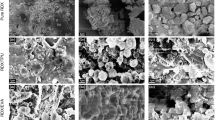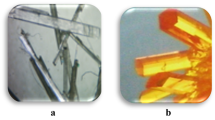Abstract
To satisfy the energy and security requirements of the explosives, it is necessary to develop high-energetic low vulnerable explosive. As the representatives of high-energetic explosives and low vulnerable explosives, hexanitrohexaazaisowurtzitane (HNIW) and 3-nitro-1,2,4-triazole-5-one (NTO) are used to research high-energetic low vulnerable polymer-bonded explosive (PBX) in this study. Based on the formulation of PAX-11 (94 mass% HNIW, 2.4 mass% CAB, 3.6 mass% BDNPA/F), some HNIW is replaced by NTO to reduce the vulnerability of the PBX during this work. Solution−water suspension method was used to prepare a series PBXs with different formulations. The explosion probability method, differential scanning calorimeter and accelerating rate calorimeter are used to evaluate the hazards of different PBX molding powders. And the thermal vulnerabilities, mechanical properties and energy levels of PBX columns are assessed by slow cook-off tests, tensile strengthes and detonation velocities, respectively. Moreover, finite element numerical simulations are adopted to study the transient temperature distributions, ignition time and ignition locations of the PBX columns during slow cook-off. The investigated results show that when the mass fraction of HNIW and NTO is 50% and 44%, respectively, the PBX passes the slow cook-off test and the detonation velocity reaches 8685 m s−1. To balance the energy and vulnerability of the PBXs, we obtain a high-energetic low vulnerable PBX formulation (50 mass% HNIW, 44 mass% NTO, 2.4 mass% CAB, 3.6 mass% BDNPA/F, 0.5 mass% additional graphite) which can be used in the warhead of the high-explosive anti-tank cartridge.










Similar content being viewed by others
References
Ou YX. Explosives. Beijing: Beijing Institute of Technology Press; 2014.
Becuwe A, Delclos A. Low sensitivity explosive compounds for low vulnerability warheads. Propell Explos Pyrot. 1993;18:1–10.
Mukundan T, Nair JK, Purandare GN, Talawar MB, Nath T, Asthana SN. Low vulnerable sheet explosive based on 3-nitro-1,2,4-triazol-5-one. J Propul Power. 2006;22:1348–52.
He GS, Yang ZJ, Zhou XY, Zhang JH, Pan LP, Liu SJ. Polymer bonded explosives (PBXs) with reduced thermal stress and sensitivity by thermal conductivity enhancement with graphene nanoplatelets. Compos Sci Technol. 2016;131:22–31.
Elbeih A, Pachman J, Zeman S, Trzcinski WA, Suceska M. Study of plastic explosives based on attractive cyclic nitramines: Part II. Detonation characteristics of explosives with polyfluorinated binders. Propell Explos Pyrot. 2013;38:238–43.
Niu H, Chen SS, Shu QH, Li LJ, Jin SH. Preparation, characterization and thermal risk evaluation of dihydroxylammonium 5, 5-bistetrazole-1, 1-diolate based polymer bonded explosive. J Hazard Mater. 2017;338:208–17.
GJB 772A, Explosive Test Method, Beijing, China, 1997.
Townsend DI, Tou JC. Thermal hazard evaluation by an accelerating rate calorimeter. Thermochim Acta. 1980;37:1–30.
Sridhar VP, Surianarayanan M, Sivapirakasam SP, Mandal AB. Adiabatic thermo kinetics and process safety of pyrotechnic mixtures. J Therm Anal Calorim. 2012;109:1387–95.
Palmer SJP, Field JE. The deformation and fracture of β-HMX. Proc R Soc A. 1982;383:399–407.
Palmer SJP, Field JE, Huntley JM. Deformation, strengths and strains to failure of polymer bonded explosives. Proc R Soc A. 1993;440:399–419.
Chen PW, Ding YS. Mechanical behavior and deformation and failure mechanisms of polymer bonded explosives. Chin J Energ Mater. 2000;8:161–4.
Berenbaum R, Brodie I. Measurement of the tensile strength of brittle materials. Br J Appl Phys. 1959;10:282–6.
Zhao YG, Fu H, Li YL, Chen R, Wen SG. Dynamic tensile mechanical properties of three types of PBX. China J Energy Mater. 2011;19:194–9.
Asante DO, Kim SH, Chae JS, Kim HS, Oh M. CFD cook-off simulation and thermal decomposition of confined high energetic material. Propell Explos Pyrot. 2015;40:699–705.
Bao F, Zhang GZ, Jin SH, Zhang CY, Niu H. Thermal decomposition and safety assessment of 3,30-dinitrimino-5,50-bis(1H-1,2,4-triazole) by DTA and ARC. J Therm Anal Calorim. 2018;132:805–11.
Bao F, Zhang GZ, Jin SH. Thermal decomposition behavior and thermal stability of DABT·2DMSO. J Therm Anal Calorim. 2018;131:3185–91.
Zhang GY, Jin SH, Li LJ, Li ZH, Shu QH, Wang DQ, Zhang B, Li YK. Evaluation of thermal hazards and thermo-kinetic parameters of 3-amino-4-amidoximinofurazan by ARC and TG. J Therm Anal Calorim. 2016;126:1223–30.
Li X, Chen SS, Zhang GY, Yu ZY, Li JX, Chen ML, Ma X, Xiang KL, Jin SH, Chen Y. Influence of energetic plasticizer bis(2,2-dinitropropyl)acetal/formal on properties of ε-CL-20 based pressed polymer-bonded explosives. Mater Express. 2017;7:216–22.
Zhang GY, Jin SH, Li LJ, Li YK, Wang DQ, Li W, Zhang T, Shu QH. Thermal hazard assessment of 4,10-dinitro-2,6,8,12-tetraoxa-4,10-diazaisowutrzitane (TEX) by accelerating rate calorimeter (ARC). J Therm Anal Calorim. 2016;126:467–71.
Zhang CY, Jin SH, Ji JW, Jing BC, Bao F, Zhang GY, Shu QH. Thermal hazard assessment of TNT and DNAN under adiabatic condition by using accelerating rate calorimeter (ARC). J Therm Anal Calorim. 2018;131:89–93.
Bao F, Zhang GZ, Jin SH, Zhang YP, Li LJ. Thermal decomposition and thermal stability of potassium 3,30-dinitrimino-5,50-bis(1H-1,2,4-triazole). J Therm Anal Calorim. 2018;133:1563–9.
Townsend DI, Tou JC. Thermal hazard evaluation by an accelerating rate calorimeter. Thermochim Acta. 1980;37:1–30.
Zou HM, Chen SS, Li X, Jin SH, Niu H, Wang F, Chao H, Fang T, Shu QH. Preparation, thermal investigation and detonation properties of ε-CL-20-based polymer-bonded explosives with high energy and reduced sensitivity. Mater Express. 2017;7:199–208.
Lv JY, Che LP, Chen WH, Gao HS, Peng MJ. Kinetic analysis and self-accelerating decomposition temperature (SADT) of dicumyl peroxide. Thermochim Acta. 2013;571:60–3.
Wang JF, Chen SS, Jin SH, Wang JY, Niu H, Zhang GY, Wang XJ, Wang DX. Size-dependent effect on thermal decomposition and hazard assessment of TKX-50 under adiabatic condition. Propell Explos Pyrot. 2018;43:488–95.
Fisher HG, Goetz DD. Determination of self-accelerating decomposition temperatures using the accelerating rate calorimeter. J Loss Prev Process Ind. 1991;4:305–16.
Liu JH, Yang ZJ, Liu SJ, Zhang JH, Liu YG. Effects of fluoropolymer binders on the mechanical properties of TATB-based PBX. Propell Explos Pyrot. 2018;43:664–70.
Mulford RN, Swift D. Sensitivity of PBX-9502 after ratchet growth. AIP Conf Proc. 2012;1426:311–4.
Sun YB, Hui JM, Cao XM. Military use blended explosives. Beijing: Weapon Industry Press; 1995.
Jin SH, Song QC. Explosive theory. Xian: Northwestern Polytechnical University Press; 2010.
Hoffman DM. Dynamic mechanical signatures of Viton A and plastic bonded explosives based on this polymer. Polym Eng Sci. 2003;43:139–56.
Aydemir E, Ulas A. A numerical study on the thermal initiation of a confined explosive in 2-D geometry. J Hazard Mater. 2011;186:396–400.
Halil I, Fatih G. Cook-off analysis of a propellant in a 7.62 mm barrel by experimental and numerical methods. Appl Therm Eng. 2017;112:484–96.
Acknowledgements
This work was supported by the Fundamental Research Funds for the Central Universities.
Author information
Authors and Affiliations
Corresponding author
Additional information
Publisher's Note
Springer Nature remains neutral with regard to jurisdictional claims in published maps and institutional affiliations.
Rights and permissions
About this article
Cite this article
Lan, G., Jin, S., Chen, M. et al. Preparation and performances characterization of HNIW/NTO-based high-energetic low vulnerable polymer-bonded explosive. J Therm Anal Calorim 139, 3589–3602 (2020). https://doi.org/10.1007/s10973-019-08743-2
Received:
Accepted:
Published:
Issue Date:
DOI: https://doi.org/10.1007/s10973-019-08743-2




